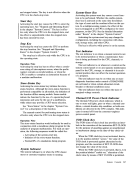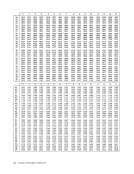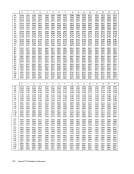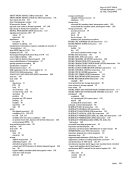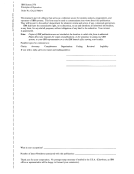malfunction that affects validity of a block of in
formation is signaled only at the completion of data
transfer. The error condition normally does not pre
maturely terminate or otherwise affect the execution
of the operation. Thus, there is no assurance that a
CCW read as data is valid until the operation is com
pleted. If the CCW thus read is in error, use of the
CCW in the current operation may cause subsequent
data to be placed in wrong locations in main storage
with resultant destruction of its contents, subject to
the control of the protection system.
Command Chaining
During command chaining, the new CCW fetched
by the channel specifies a newI/O operation. The
channel fetches the new CCW and initiates the new
operation upon the receipt of the device-end signal
for the current operation. When command chaining
takes place, the completion of the current operation
does not cause anI/O interruption, and the count
indicating the amount of data transferred during the
current operation is not made available to the pro
gram. For operations involving data transfer, the
new command always applies to the next block of
data at the device.
Command chaining takes place and the new oper
ation is initiated only if no unusual conditions have
been detected in the current operation. In particular,
the channel initiates a newI/O operation·by com
mand chaining upon receipt of a status byte contain
ing only the following bit combinations: device end,
device end and status modifier, device end and chan
nel end, device end and channel end and status modi
fier. In the former two cases a channel end must
have been signaled before device end, with all other
status bits off. If a condition such as attention, unit
check, unit exception, incorrect length, program
check, or protection check has occurred, the se
quence of operations is concluded, and the status
associated with the current operation causes an in
terruption condition to be generated. The new CCW
in this case is not fetched. The incorrect-length con
dition does not suppress command chaining if the
current CCW has theSLI flag on.
An exception to sequential chaining of CCWs
occurs when theI/O device presents the status
modifier condition with the device-end signal. When
command chaining is specified and no unusual con
ditions have been detected, the combination of
status-modifier and device-end bits causes the chan
nel to fetch and chain to the CCW whose main
storage address is 16 higher than that of the current
CCW.
When both command and data chaining are used,
the first CCW associated with
fies the operation to be executed, and the last CCW
indicates whether another operation follows.
Programming Note
Command chaining makes it possible for the pro
gram to initiate transfer of multiple blocks of data by
means of a single STARTI/O or START I/O FAST
RELEASE. It also permits a subchannel to be set up
for execution of auxiliary functions, such as position
ing the disk-access mechanism, and for data-transfer
operations without interference by the program at
the end of each operation. Command chaining, in
conjunction with the status-modifier condition, per
mits the channel to modify the normal sequence of
operations in response to signals provided by theI/O device.
Skipping
Skipping is the suppression of main-storage refer
ences during anI/O operation. It is defined only for
read, read backward, and sense operations, and is
controlled by the skip flag, which can be specified
individually for each CCW. When the skip flag is
one, skipping occurs; when zero, normal operation
takes place. The setting of the skip flag is ignored in
all other operations.
Skipping affects only the handling of information
by the channel. The operation at theI/O device
proceeds normally, and information is transferred to
the channel. The channel keeps updating the count
but does not place the information in main storage.
Chaining is not precluded by skipping. In the case of
data chaining, normal operation is resumed if the
skip flag in the new CCW is zero.
No checking for invalid or protected data address
es takes place during skipping.
Programming Note
Skipping, when combined with data chaining, per
mits the program to place in main storage selected
portions of a block of information from anI/O de
vice.
Program-Controlled Interruption
The program-controlled interruption (PCI) function
permits the program to cause anI/O interruption
during execution of anI/O operation. The function
is controlled by the PCI flag in the CCW. The flag
can be on either in the first CCW specified by
STARTI/O or START I/O FAST RELEASE or in
a CCW fetched during chaining. Neither the PCI
flag nor the associated interruption affects the execu
tion of the current operation.
Whenever the PCI flag in the CCW is on, the
channel attempts to interrupt the program. When the
Input/Output Operations 215
formation is signaled only at the completion of data
transfer. The error condition normally does not pre
maturely terminate or otherwise affect the execution
of the operation. Thus, there is no assurance that a
CCW read as data is valid until the operation is com
pleted. If the CCW thus read is in error, use of the
CCW in the current operation may cause subsequent
data to be placed in wrong locations in main storage
with resultant destruction of its contents, subject to
the control of the protection system.
Command Chaining
During command chaining, the new CCW fetched
by the channel specifies a new
channel fetches the new CCW and initiates the new
operation upon the receipt of the device-end signal
for the current operation. When command chaining
takes place, the completion of the current operation
does not cause an
indicating the amount of data transferred during the
current operation is not made available to the pro
gram. For operations involving data transfer, the
new command always applies to the next block of
data at the device.
Command chaining takes place and the new oper
ation is initiated only if no unusual conditions have
been detected in the current operation. In particular,
the channel initiates a new
mand chaining upon receipt of a status byte contain
ing only the following bit combinations: device end,
device end and status modifier, device end and chan
nel end, device end and channel end and status modi
fier. In the former two cases a channel end must
have been signaled before device end, with all other
status bits off. If a condition such as attention, unit
check, unit exception, incorrect length, program
check, or protection check has occurred, the se
quence of operations is concluded, and the status
associated with the current operation causes an in
terruption condition to be generated. The new CCW
in this case is not fetched. The incorrect-length con
dition does not suppress command chaining if the
current CCW has the
An exception to sequential chaining of CCWs
occurs when the
modifier condition with the device-end signal. When
command chaining is specified and no unusual con
ditions have been detected, the combination of
status-modifier and device-end bits causes the chan
nel to fetch and chain to the CCW whose main
storage address is 16 higher than that of the current
CCW.
When both command and data chaining are used,
the first CCW associated with
fies the operation to be executed, and the last CCW
indicates whether another operation follows.
Programming Note
Command chaining makes it possible for the pro
gram to initiate transfer of multiple blocks of data by
means of a single START
RELEASE. It also permits a subchannel to be set up
for execution of auxiliary functions, such as position
ing the disk-access mechanism, and for data-transfer
operations without interference by the program at
the end of each operation. Command chaining, in
conjunction with the status-modifier condition, per
mits the channel to modify the normal sequence of
operations in response to signals provided by the
Skipping
Skipping is the suppression of main-storage refer
ences during an
read, read backward, and sense operations, and is
controlled by the skip flag, which can be specified
individually for each CCW. When the skip flag is
one, skipping occurs; when zero, normal operation
takes place. The setting of the skip flag is ignored in
all other operations.
Skipping affects only the handling of information
by the channel. The operation at the
proceeds normally, and information is transferred to
the channel. The channel keeps updating the count
but does not place the information in main storage.
Chaining is not precluded by skipping. In the case of
data chaining, normal operation is resumed if the
skip flag in the new CCW is zero.
No checking for invalid or protected data address
es takes place during skipping.
Programming Note
Skipping, when combined with data chaining, per
mits the program to place in main storage selected
portions of a block of information from an
vice.
Program-Controlled Interruption
The program-controlled interruption (PCI) function
permits the program to cause an
during execution of an
is controlled by the PCI flag in the CCW. The flag
can be on either in the first CCW specified by
START
a CCW fetched during chaining. Neither the PCI
flag nor the associated interruption affects the execu
tion of the current operation.
Whenever the PCI flag in the CCW is on, the
channel attempts to interrupt the program. When the
Input/Output Operations 215
























































































































































































































































